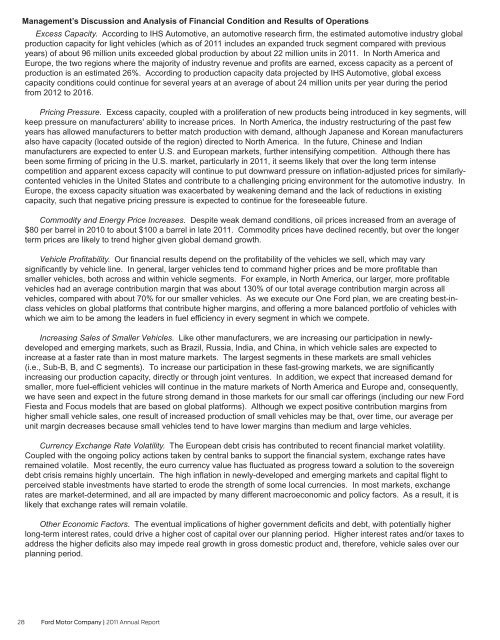PROFITABLE GROWTH FOR ALL
Create successful ePaper yourself
Turn your PDF publications into a flip-book with our unique Google optimized e-Paper software.
Management’s Discussion and Analysis of Financial Condition and Results of Operations<br />
Excess Capacity. According to IHS Automotive, an automotive research firm, the estimated automotive industry global<br />
production capacity for light vehicles (which as of 2011 includes an expanded truck segment compared with previous<br />
years) of about 96 million units exceeded global production by about 22 million units in 2011. In North America and<br />
Europe, the two regions where the majority of industry revenue and profits are earned, excess capacity as a percent of<br />
production is an estimated 26%. According to production capacity data projected by IHS Automotive, global excess<br />
capacity conditions could continue for several years at an average of about 24 million units per year during the period<br />
from 2012 to 2016.<br />
Pricing Pressure. Excess capacity, coupled with a proliferation of new products being introduced in key segments, will<br />
keep pressure on manufacturers' ability to increase prices. In North America, the industry restructuring of the past few<br />
years has allowed manufacturers to better match production with demand, although Japanese and Korean manufacturers<br />
also have capacity (located outside of the region) directed to North America. In the future, Chinese and Indian<br />
manufacturers are expected to enter U.S. and European markets, further intensifying competition. Although there has<br />
been some firming of pricing in the U.S. market, particularly in 2011, it seems likely that over the long term intense<br />
competition and apparent excess capacity will continue to put downward pressure on inflation-adjusted prices for similarlycontented<br />
vehicles in the United States and contribute to a challenging pricing environment for the automotive industry. In<br />
Europe, the excess capacity situation was exacerbated by weakening demand and the lack of reductions in existing<br />
capacity, such that negative pricing pressure is expected to continue for the foreseeable future.<br />
Commodity and Energy Price Increases. Despite weak demand conditions, oil prices increased from an average of<br />
$80 per barrel in 2010 to about $100 a barrel in late 2011. Commodity prices have declined recently, but over the longer<br />
term prices are likely to trend higher given global demand growth.<br />
Vehicle Profitability. Our financial results depend on the profitability of the vehicles we sell, which may vary<br />
significantly by vehicle line. In general, larger vehicles tend to command higher prices and be more profitable than<br />
smaller vehicles, both across and within vehicle segments. For example, in North America, our larger, more profitable<br />
vehicles had an average contribution margin that was about 130% of our total average contribution margin across all<br />
vehicles, compared with about 70% for our smaller vehicles. As we execute our One Ford plan, we are creating best-inclass<br />
vehicles on global platforms that contribute higher margins, and offering a more balanced portfolio of vehicles with<br />
which we aim to be among the leaders in fuel efficiency in every segment in which we compete.<br />
Increasing Sales of Smaller Vehicles. Like other manufacturers, we are increasing our participation in newlydeveloped<br />
and emerging markets, such as Brazil, Russia, India, and China, in which vehicle sales are expected to<br />
increase at a faster rate than in most mature markets. The largest segments in these markets are small vehicles<br />
(i.e., Sub-B, B, and C segments). To increase our participation in these fast-growing markets, we are significantly<br />
increasing our production capacity, directly or through joint ventures. In addition, we expect that increased demand for<br />
smaller, more fuel-efficient vehicles will continue in the mature markets of North America and Europe and, consequently,<br />
we have seen and expect in the future strong demand in those markets for our small car offerings (including our new Ford<br />
Fiesta and Focus models that are based on global platforms). Although we expect positive contribution margins from<br />
higher small vehicle sales, one result of increased production of small vehicles may be that, over time, our average per<br />
unit margin decreases because small vehicles tend to have lower margins than medium and large vehicles.<br />
Currency Exchange Rate Volatility. The European debt crisis has contributed to recent financial market volatility.<br />
Coupled with the ongoing policy actions taken by central banks to support the financial system, exchange rates have<br />
remained volatile. Most recently, the euro currency value has fluctuated as progress toward a solution to the sovereign<br />
debt crisis remains highly uncertain. The high inflation in newly-developed and emerging markets and capital flight to<br />
perceived stable investments have started to erode the strength of some local currencies. In most markets, exchange<br />
rates are market-determined, and all are impacted by many different macroeconomic and policy factors. As a result, it is<br />
likely that exchange rates will remain volatile.<br />
Other Economic Factors. The eventual implications of higher government deficits and debt, with potentially higher<br />
long-term interest rates, could drive a higher cost of capital over our planning period. Higher interest rates and/or taxes to<br />
address the higher deficits also may impede real growth in gross domestic product and, therefore, vehicle sales over our<br />
planning period.<br />
28 Ford Motor Company | 2011 Annual Report


